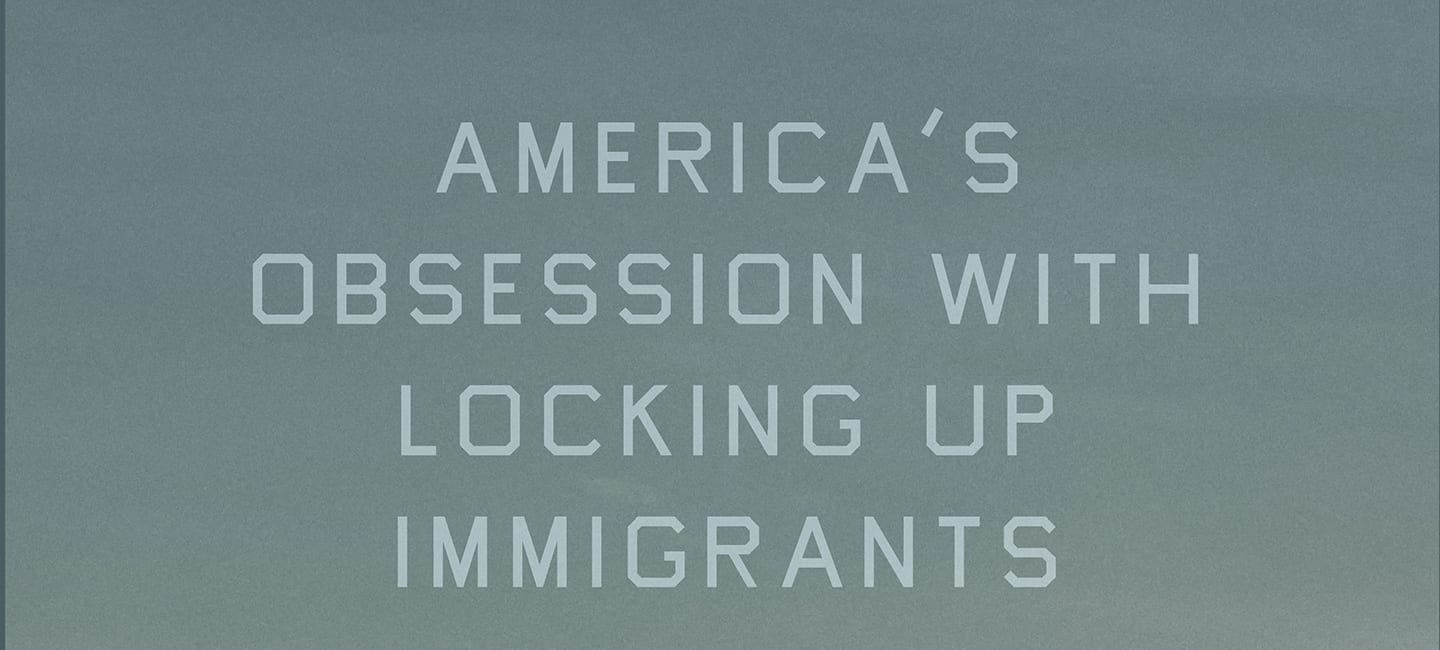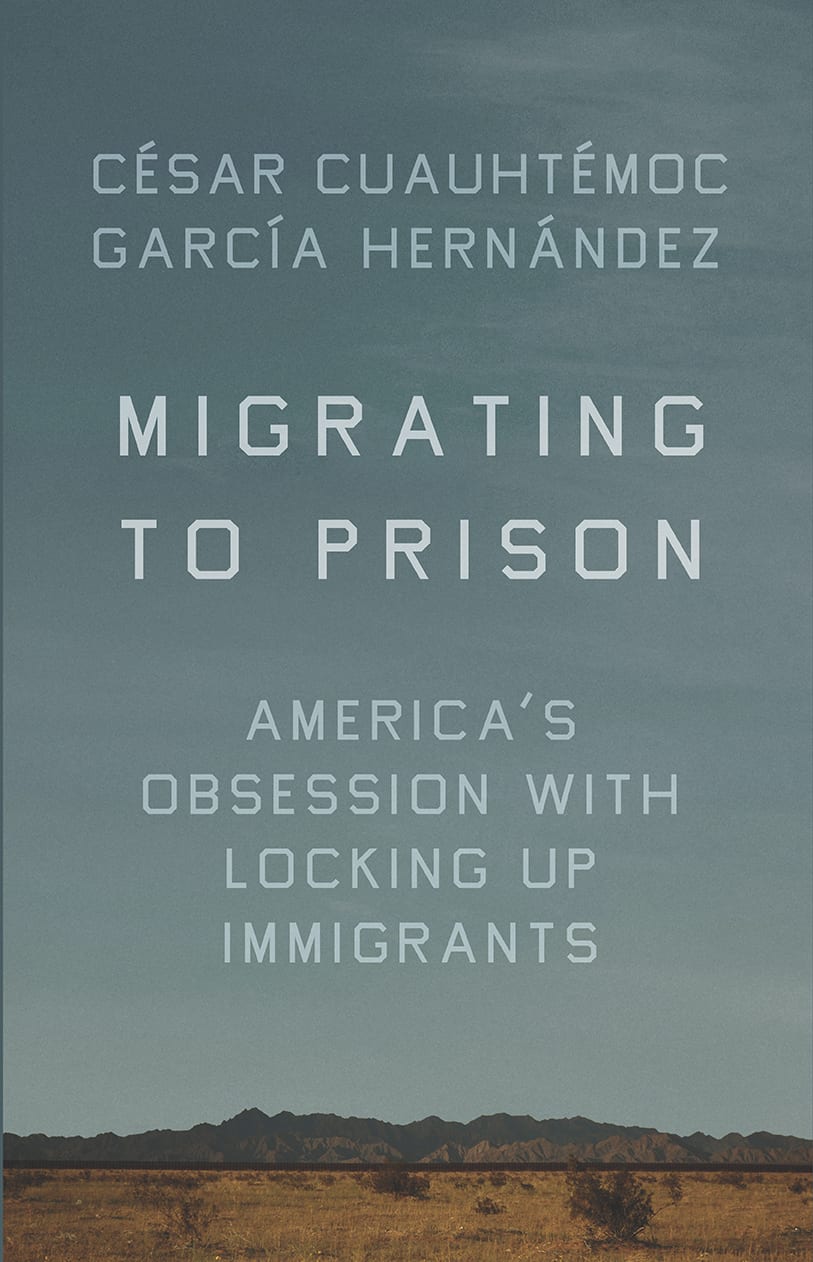
Un extracto especial del próximo libro de César Cuauhtémoc García Hernández "Migrar a prisión: La obsesión de Estados Unidos por encerrar a los inmigrantes"
Las autoridades estadounidenses encierran a los migrantes como ningún otro país. Durante los últimos treinta años, tanto el gobierno federal como los estatales han criminalizado cada vez más la migración transfronteriza. Como resultado, Estados Unidos tiene hoy el mayor sistema de detención de inmigrantes del mundo. Anualmente, alrededor de medio millón de personas pasan algún tiempo entre sus rejas.

En su segundo libro, "Migrar a la cárcel: America's Obsession with Locking Up Immigrants" (Encerrar a los inmigrantes) destacado especialista en migración César Cuauhtémoc García Hernández toma un dura mirada a la aparición del encarcelamiento de inmigrantes a mediados de la década de 1980. Explica cómo funciona en la actualidad y por qué los gobiernos federal y estatales han encarcelado cada vez a más personas. personas acusadas de violar las leyes de inmigración. Aquí, pide a los lectores que imaginen cómo podría ser la abolición de las prisiones de inmigrantes y un rediseño radical de la migración a Estados Unidos.
El libro, que saldrá a la venta el 3 de diciembre, utiliza análisis e historias personales de personas atrapadas en la "industria del encarcelamiento de inmigrantes" de Estados Unidos para demostrar que el sistema no ha funcionado mal. Por el contrario, Hernández sostiene que funciona exactamente como fue diseñado.
Ahora, Borderless Magazine comparte algunos de los análisis de este destacado académico sobre la preocupante intersección de la inmigración y el sistema penitenciario en Estados Unidos.
Hoy en día, el encarcelamiento de inmigrantes es la norma, pero en Estados Unidos, mientras que el confinamiento ha sido durante mucho tiempo una característica central de los procesos penales, ha sido una anomalía cuando se trata de la aplicación de la ley de inmigración. Durante la mayor parte de la historia de la nación, no encerramos a tanta gente por el hecho de emigrar. La mayoría de las veces, los agentes del gobierno hacían la vista gorda ante los inmigrantes que se saltaban la ley, dejándoles entrar en Estados Unidos o devolviéndoles rápidamente y, en comparación con hoy, sin dolor. Si cometían un delito, debían cumplir su condena; después, podían regresar a sus comunidades en Estados Unidos. De hecho, la ley de inmigración y la ley penal estaban separadas, y la ciudadanía no influía en si una persona acababa o no entre rejas.
Las estadísticas gubernamentales lo confirman. A lo largo de los siglos XIX y XX, pocas personas fueron expulsadas por la fuerza de Estados Unidos a causa de una condena. Durante las nueve décadas que van de 1892 a 1984, los funcionarios federales de inmigración expulsaron formalmente de Estados Unidos a 633.918 personas. De ellas, sólo 14.287 fueron tratadas de esa manera debido a actividades delictivas. Del mismo modo, los funcionarios deportaron a 812.915 personas entre 1908 y 1980, pero sólo a 56.669 por un delito penal. En su mayor parte, a los funcionarios les preocupaba más que los pobres acabaran en la asistencia social o que la gente no hubiera cumplido los requisitos de la solicitud de visado. Mientras tanto, los fiscales federales rara vez recurrían al poder del derecho penal para perseguir a los inmigrantes. Aunque entrar en Estados Unidos sin permiso del gobierno federal fue un delito durante la mayor parte del siglo XX, los fiscales rara vez intentaron condenar a personas por hacerlo. En 1970, los fiscales sólo acusaron a 575 personas de un delito de inmigración. Incluso en 1993, sólo presentaron cargos por delitos de inmigración en 2.487 casos, apenas el 5% de los casos enjuiciados ese año.
No es sorprendente que pocas personas fueran encarceladas por su condición de inmigrantes. Es difícil encontrar estadísticas penitenciarias fiables que se remonten a décadas atrás, pero en 1994 solo había 8.604 personas encerradas al año por delitos federales de inmigración. Sin embargo, esa cifra aumentó a 97.982 en 2013, un descomunal aumento del 1.039%. Las tasas de encarcelamiento han cambiado de manera similar para las personas realmente condenadas por un delito federal de inmigración. En 1990, había 1.728 condenados por delitos de inmigración encerrados en un día normal, pero en 2013 había 19.100. En 1973, el Servicio de Inmigración y Naturalización (INS) detuvo a sólo 2.370 personas cada día, y en 1980 ese número había aumentado a 4.062. Pero en los últimos meses de la administración Obama, el ICE detenía a unas 40.000 personas al día, una cifra que pronto aumentaría bajo la presidencia de Trump, superando las 42.000 diarias en 2018.
Durante los últimos treinta años, tanto el gobierno federal como los gobiernos estatales han hecho uso cada vez más frecuente de sus facultades para encarcelar a personas por la forma en que cruzan las fronteras. Como resultado, Estados Unidos tiene el sistema de detención de inmigrantes más grande del mundo, en el que más de medio millón de personas al año pasan tiempo encerradas porque el gobierno alega que violaron la ley de inmigración. Incluso con cifras récord de inmigrantes encerrados, menos de seis meses después de iniciada la administración Trump, el Congreso aumentó la financiación para la detención del ICE y los fiscales federales encargados de perseguir las condenas penales contra los inmigrantes que llegaron a Estados Unidos sin el permiso del gobierno federal.

A pesar de la magnitud sin precedentes históricos del encarcelamiento de inmigrantes, a menudo se pasa por alto su enorme alcance en las conversaciones sobre inmigración y justicia penal, y cuando se menciona, los defensores, periodistas y académicos tienden a dividir el confinamiento en dos tipos: la detención civil de inmigrantes y el encarcelamiento penal punitivo. Supuestamente, la detención civil no castiga; el encarcelamiento penal, sí. Aunque es correcta desde el punto de vista del derecho formal, esta distinción es una farsa sobre el terreno. No refleja la realidad del control policial de la inmigración ni la experiencia vivida por los inmigrantes. Diga lo que diga la ley, la conducta que conduce al encarcelamiento por motivos de inmigración y las condiciones de reclusión son en gran medida idénticas en la división civil/penal. E independientemente de su etiqueta formal, el encarcelamiento por motivos de inmigración suele tener un efecto devastador en los detenidos, sus familias y sus comunidades.
Al igual que su primo policial más conocido -el encarcelamiento masivo como castigo penal-, la historia del encarcelamiento de inmigrantes surge en medio de los debates racialmente codificados de mediados de la década de 1980, cuando los legisladores basaron la guerra contra las drogas en la amenaza que supuestamente representaban las personas de color. Mucho antes de que Donald Trump saliera en las páginas de los tabloides, los políticos afirmaban que los inmigrantes eran responsables de una parte sustancial del tráfico de drogas. Desde la Casa Blanca hasta las páginas de los principales periódicos y revistas, se propagaron rumores de que los inmigrantes traficaban con la muerte y la decadencia inducidas por las drogas en el paisaje urbano. Más recientemente, el miedo exagerado a los terroristas musulmanes impulsó el encarcelamiento de inmigrantes. Inmediatamente después de los atentados del 11 de septiembre de 2001, los musulmanes sospechosos de infringir la ley de inmigración -y nada más- fueron recluidos en pabellones de alta seguridad de prisiones federales de máxima seguridad. Añadiendo su propio énfasis a esta historia de décadas, el presidente Trump cambió la atención del gobierno federal a las pandillas. Quienquiera que haya estado en el cargo, durante tres décadas el presidente, los funcionarios del gabinete y los principales asesores han afirmado que debemos encarcelar a nuestra manera a un sistema de inmigración-ley funcional.
Con toda la histeria sobre las drogas, el terrorismo y las bandas, no es de extrañar que la gran mayoría de las personas encerradas en prisiones de inmigración sean personas de color. No sólo la policía se centra desproporcionadamente en los inmigrantes negros y morenos, sino que también lo hace la policía de inmigración, a pesar de la presencia de muchos inmigrantes canadienses y europeos que también violan la ley de inmigración. "Históricamente, tenemos constancia de que por la frontera norte de Canadá entran más terroristas que por la frontera sur", declaró en 2007 Asa Hutchinson, alto cargo del DHS bajo la presidencia de George W. Bush, cuando la agencia estaba reclutando furiosamente agentes de habla hispana para la Patrulla Fronteriza. ¿Cómo debería responder el gigantesco departamento que él ayudó a dirigir a la amenaza del norte? "La mejor seguridad fronteriza en la frontera norte es la abuela que lleva setenta años viviendo en su casa de la frontera. Se sienta en su casa, vigila la frontera y llama a la patrulla fronteriza cuando ve algo sospechoso", explicó Hutchinson. En el norte, contamos con las abuelas en sus salones. En el sur, contamos con prisiones, agentes y muros.
Espoleados por el miedo racializado a la anarquía, o aprovechándose de él, los miembros de la derecha política consideran a los inmigrantes, especialmente a los no ciudadanos con antecedentes penales, un riesgo para la seguridad nacional y una amenaza para el Estado de derecho. Son "criminales", dijo en 2013 el ex presidente republicano de la Cámara de Representantes John Boehner. En su primera visita a la frontera sur como fiscal general, Jeff Sessions dio instrucciones a los fiscales federales de todo el país para que dieran prioridad a los casos de delitos de inmigración. "Los extranjeros criminales y los coyotes y falsificadores de documentos buscan derrocar nuestro sistema de inmigración legal", dijo a un grupo de agentes de la Patrulla Fronteriza reunidos en Nogales, Arizona. "Es aquí, en este trozo de tierra, donde primero nos enfrentamos a esta inmundicia". Al mismo tiempo, muchos defensores mantienen alejados a los inmigrantes con antecedentes penales por temor a que la asociación con los miembros más antipáticos de las comunidades inmigrantes pueda empañar los esfuerzos más amplios de reforma de la inmigración. A veces, el silencio puede pesar tanto como las palabras más crudas.
Copyright © 2019 de César Cuauhtémoc García Hernández. Este fragmento apareció originalmente en "Migrar a la cárcel: La obsesión de Estados Unidos por encerrar a los inmigrantespublicado por The New Press y reproducido aquí con permiso.
Borderless Magazine es su fuente de historias que trascienden fronteras. Usted puede apoye nuestro trabajo con una donación libre de impuestos hoy mismo.
